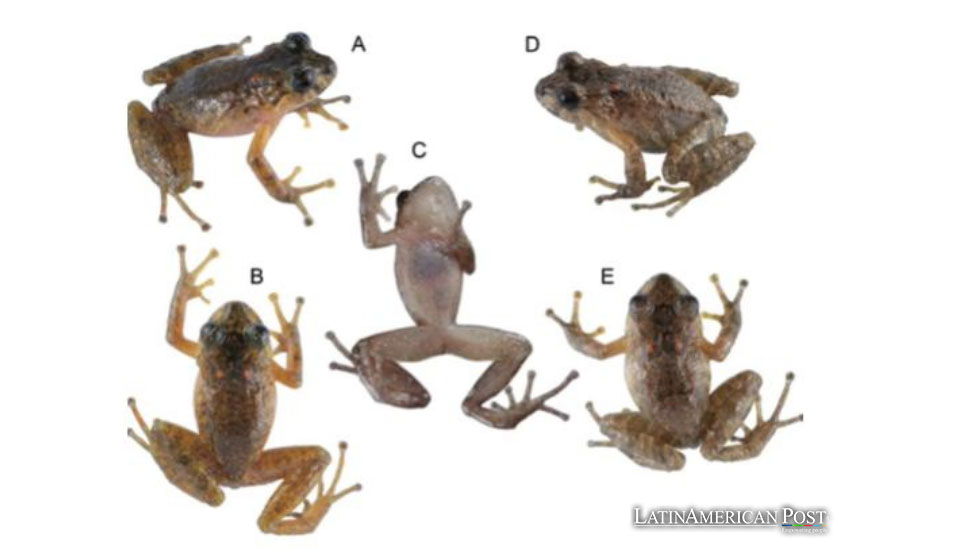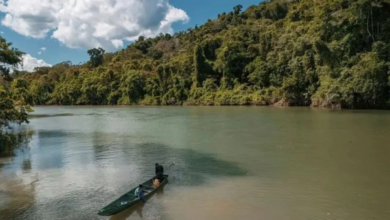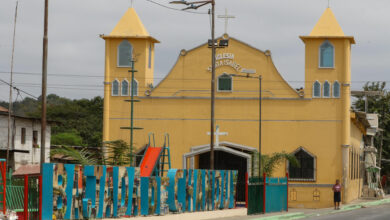One Hundred Years of Solitude: Rediscovering Ecuador’s Lost Frog

Hidden in Ecuador’s Andean forests for over a century, the Molleturo robber frog has been rediscovered, offering new hope for the conservation of rare species. This thrilling find highlights the importance of preserving Ecuador’s unique montane habitats.
In the high-altitude forests of Ecuador’s Andes, where the dense foliage of montane forests conceals countless secrets, a small creature with striking orange eyes has eluded the gaze of scientists for over a century. The Molleturo robber frog, Pristimantis ruidus, once thought to be extinct, has been rediscovered, breathing new life into the ongoing efforts to preserve Ecuador’s biodiversity. This remarkable find underscores the vital importance of conserving the country’s montane forests, which continue to harbor rare and enigmatic species.
A Century of Mystery
The story of the Molleturo robber frog begins in 1922, when British-American naturalist George Henry Hamilton Tate embarked on an expedition to the Pacific slopes of the Ecuadorian Andes. Working on behalf of the American Museum of Natural History, Tate sought to explore the region’s rich biodiversity and document its unique fauna. During this journey, nearly 8,000 feet above sea level, he encountered a previously unknown species of frog, which he named Pristimantis ruidus. Tate collected 16 specimens of the frog, marking the first—and for many years, the only—time it would be recorded in scientific literature.
Despite this initial discovery, the frog seemingly vanished from scientific observation, leading researchers to wonder if it had succumbed to the pressures that have driven many species to extinction. For decades, the Molleturo robber frog existed only in the pages of old journals and the minds of a few determined herpetologists who refused to believe that it had truly disappeared.
In 2022, a research team embarked on a journey to the Quitahuaycu Conservation Reserve, a remote area nestled in the southern reaches of Ecuador’s Andes mountains. The reserve, which is one of the last remnants of West Andean Montane Forest in the region, had long been considered a potential refuge for undiscovered or presumed extinct species. Guided by the possibility that the Molleturo robber frog might still be out there, the team conducted an exhaustive search of the forest’s understory, leaving no stone—or shrub—unturned.
Their persistence paid off. As night fell, the researchers spotted two frogs with the distinctive warty skin and orange eyes described by Tate a century earlier. These frogs, perched on fallen trees and low shrubs near a stream, were unmistakably Pristimantis ruidus. For the first time, the frog was photographed in its natural habitat, providing crucial documentation of its existence and appearance.
The frogs’ coloration, an “olive clay” hue with “verona brown blotches” on their backs, and “olive sulfur yellow” snouts with “lime green” eyelids, matched Tate’s descriptions. However, the rediscovery also revealed new details, particularly about the frog’s behavior. While previous accounts suggested that the frog was typically found under rocks, the new observations indicated that it might be more active on shrubs and vegetation during the night, retreating to the safety of rocks and logs during the day.
Understanding the Molleturo Robber Frog
The Molleturo robber frog is a small, moderately sized amphibian whose rough, warty skin gives it a unique texture and appearance. Its name, Pristimantis guides, is derived from Latin. ” Guides ” means rough, a nod to the frog’s distinctive skin. Molleturo, added following its rediscovery, refers to the parish in southern Ecuador where the frog was found.
A. Dorso-lateral view; B. Dorsal view; C. Ventral view; SVL = 30.0 mm.
Female MUTPL 1613; D. Dorso-lateral view; E. Dorsal view; SVL = 20.1 mm. Photographs: Jaime Culebras, Juan Sánchez.
The species’ striking appearance is characterized by light chrome orange eyes, which contrast vividly with its earthy body tones. These features not only make the frog a fascinating subject for scientific study but also emphasize the importance of visual markers in species identification—a critical factor in the conservation of cryptic species like the Molleturo robber frog.
The rediscovery of the Molleturo robber frog is not just a triumph for herpetologists; it is a beacon of hope for conservationists working to protect Ecuador’s fragile ecosystems. The frog’s reappearance after a century of obscurity demonstrates that there are still pockets of pristine habitat within the Andes that can support rare and threatened species. It also highlights the resilience of these species, which have managed to survive despite the widespread environmental changes that have occurred over the past hundred years.
Ecuador’s montane forests, like those in the Quitahuaycu Conservation Reserve, are among the most biologically diverse ecosystems on the planet. However, they are also some of the most threatened. Deforestation, climate change, and human encroachment have all taken their toll on these habitats, leading to the loss of countless species and the degradation of the ecosystems they depend on. The rediscovery of the Molleturo robber frog reinforces the urgent need to protect these remaining natural areas.
Conservation Efforts and Challenges
The Quitahuaycu Conservation Reserve, where the Molleturo robber frog was rediscovered, plays a crucial role in the preservation of Ecuador’s montane forests. The reserve is part of a broader effort to protect the country’s natural heritage, which includes not only frogs but also a vast array of other flora and fauna that are endemic to the region.
Conservation in the Andes is not without its challenges. The rugged terrain and remote locations of many of these habitats make them difficult to access and study. Moreover, the pressures of agriculture, logging, and infrastructure development continue to threaten these areas, despite efforts to establish protected zones. In this context, the rediscovery of Pristimantis ruidus serves as a powerful reminder of what could be lost if these threats are not addressed.
The research team that rediscovered the Molleturo robber frog, including Juan Sánchez-Nivicela, Diana Székely, Luis Salagaje M., Nicolás Astudillo-Abad, Jaime Culebras, Ernesto Arbeláez Ortiz, and Paul Székely, has emphasized the importance of preserving the frog’s habitat. Their findings suggest that the frog’s survival is closely tied to the health of the montane forest ecosystem, which provides the shelter and resources the species needs to thrive.
The Role of Conservation in Ecuador
The rediscovery of the Molleturo robber frog has reignited interest in the conservation of Ecuador’s montane forests. Researchers and conservationists are now calling for increased efforts to protect these critical habitats, which are home to numerous other species that are likely to be just as rare and elusive as the Molleturo robber frog.
One of the key strategies for conservation in Ecuador is the establishment of more protected areas like the Quitahuaycu Conservation Reserve. These reserves not only safeguard the habitats of threatened species but also provide opportunities for scientific research and ecotourism, both of which can contribute to the long-term sustainability of conservation efforts.
In addition to expanding protected areas, conservationists are also advocating for more comprehensive monitoring and research programs. These initiatives are essential for understanding the complex dynamics of montane forest ecosystems and for identifying the species that are most at risk. By studying these ecosystems in greater detail, researchers can develop more effective conservation strategies that address the specific needs of different species, including the Molleturo robber frog.
Public Awareness and Education
Public awareness and education are also critical components of successful conservation efforts. The story of the Molleturo robber frog’s rediscovery offers a compelling narrative that can inspire people to take action to protect the environment. By raising awareness about the importance of biodiversity and the threats facing Ecuador’s ecosystems, conservationists hope to garner greater support for their work.
Educational programs, particularly those targeting local communities, are vital for fostering a sense of stewardship over the natural environment. In the areas surrounding the Quitahuaycu Conservation Reserve, efforts are being made to engage local residents in conservation activities, such as reforestation projects and sustainable land use practices. These initiatives not only help protect the habitat of the Molleturo robber frog but also provide economic benefits to the community, creating a win-win situation for both people and wildlife.
A Symbol of Hope for Ecuador’s Biodiversity
The rediscovery of the Molleturo robber frog after a century of obscurity is a powerful symbol of hope for the future of Ecuador’s biodiversity. It reminds us that, even in the face of overwhelming challenges, there are still hidden corners of the world where rare and extraordinary species continue to survive. This discovery is a testament to the resilience of nature and the importance of continued conservation efforts.
As scientists continue to explore the montane forests of Ecuador, there is a renewed sense of optimism that more species, once thought lost, may yet be found. The story of the Molleturo robber frog is just one chapter in the ongoing effort to understand and protect the rich natural heritage of Ecuador. With the support of researchers, conservationists, and the public, there is hope that this heritage will be preserved for future generations to appreciate and enjoy.
Also read: New Species of Glass Frog Discovered in Ecuador
The tale of this tiny, orange-eyed frog serves as a poignant reminder of the wonders that still await discovery in the natural world and the vital role that conservation plays in ensuring these wonders endure.





